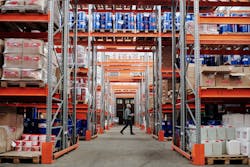Did you know that approximately 5% of warehouse workers experience an injury on the job every year? Most of these injuries could have been prevented with effective safety programs and proper lighting.
As an electrical contractor, your goal should be to install high-quality, reliable lighting systems. When the application is for a fast-paced warehouse bustling with activity, the right lighting system facilitates seamless operations and enhances workplace safety. It can also improve employee performance by reducing work errors and potential damage to the property. A quality lighting system can also improve employees' concentration levels, resulting in a productive work environment.
Here are some best practices to follow when installing or retrofitting warehouse lighting systems.
Understand the needs of the warehouse.
Warehouses are unique depending on their layout and use. There is no one-size-fits-all approach for light placements in warehouses. Understanding the specific usage of the facility is essential for determining the best lighting arrangement.
A warehouse is usually divided into various sections such as the loading areas, order packing zones, storage areas, and others. Determining what tasks are conducted in each of these areas will give you a good sense of the ideal light levels.
For example, loading areas are generally crowded with forklifts, conveyors, or boom lifts. To ensure the safety of workers and equipment, it is important to use the appropriate lights in such areas. One of our Lighting Specialists, Tyler, recommends that in warehouses where the ceiling height is 20 - 25 ft we typically suggest 22,500 lumens 150 watt LED UFO high bay lights. For ceiling heights over 35 ft, we've found 45,000 lumens 300 watt LED UFO high bay lights are a great fit. This said, he always recommends a photometric study for new construction warehouses. This helps identify the best fixture for the desired light level. Administrative offices within warehouses require cool lighting for easy reading and writing. Offices typically have a 2x2 or 2x4 grid ceiling and our LED panels that match the grid size. We typically recommend 5000k color temperature lights to achieve the cool lighting that's often desired in this type of space.
Select the best location for luminaires.
Now that you know that every area in the warehouse needs a custom lighting solution, focus on finding the right locations for each luminaire to ensure an optimal layout. Failing to appropriately layout the space could easily result in non-uniform light distribution, poor visibility, and glare. Complete your lighting layout plan well before you begin work to avoid this risk.
Choose locations that illuminate the entire area uniformly, thereby helping the workers perform their tasks efficiently. For example, placing luminaires on the ceiling above storage areas could create shadows or dark spots once materials begin stacking up. This can lead to accidents in the workplace. In some cases, placing luminaires over the top of the shelves will be beneficial to illuminate the racks.
Similarly, the aisles should be properly lit as they are frequented by heavy moving equipment, such as forklifts, boom lifts, and hand trucks.
Select the right luminaires.
To create an ideal work environment in a warehouse, it is essential to install luminaires outfitted with the appropriate specifications and options. LED luminaires are ideal for warehouses for many reasons, such as high output, low maintenance, reduced energy consumption, and long product life. Choose a high-quality but cost-effective LED luminaire to outfit the entire warehouse area.
Because warehouses feature large open spaces, it is necessary to determine the intensity of light required for illumination. Most commercial warehouses need light levels from 20 to 40 footcandles. Understand the warehouse layout and its sections before calculating the lighting levels required for each space.
Depending on the area that requires illumination, choose either Type I or Type V light distribution. As the name suggests, Type I refers to a tight beam of light emitted from the source. Conversely, Type V is a light beam emitting light in an inverted V covering a circular or square area.
If you have observed glare issues in the warehouse, it is best to use anti-glare LED luminaires. You can also use frosted lenses or install reflectors on existing luminaires to eliminate glare.
Adopt smart lighting systems.
Installing LED luminaires with smart controls can help reduce energy usage and waste. This cost-effective lighting solution can reduce energy usage by up to 30% as lights can be turned on and off based on whether an employee is in that area of the warehouse or not.
You can also install dimmers or timers to control the light output in areas that are not being used. Similarly, luminaires equipped with motion sensors or occupancy sensors can automatically detect motion to turn on the lights. In the absence of motion, the light is automatically switched off.
Undertake regular luminaire maintenance.
Proper maintenance of luminaires can ensure that standard quality of light is distributed across all areas of the warehouses.
- Check and replace the luminaires that are no longer producing enough light. If you have a multi-lamp fitting, replace the non-working components.
- Check the luminaires for loose connections or wiring problems and fix them accordingly.
- Clean the fixture lenses in the warehouses to remove dirt, debris, and dust. This can increase the light level.
- Wipe the luminaires and diffusers clean to remove the dirt accumulated on the exterior parts.
- Discard outdated and inefficient lamps and replace them with high-performing ones, such as with LEDs.
- Consider redesigning the lighting layout if the warehouse layout has been altered from its original plan.
Conclusion
Electrical contractors can leverage their expertise in various lighting systems to build a safe and secure environment in warehouses. Follow the best practices outlined above to design excellent lighting solutions for your customers.
Cory Peterson is Director of Sales & Marketing at LED Lighting Supply where he focuses on improving customer experience and revenue operations. Cory writes about commercial, industrial and sport lighting, along with topics important to contractors and facility managers. In his free time, Cory enjoys traveling, snorkeling, boxing and cooking. He can be reached at [email protected].
About the Author
Cory Peterson
Cory Peterson is Director of Sales & Marketing at LED Lighting Supply where he focuses on improving customer experience and revenue operations. Cory writes about commercial, industrial and sport lighting, along with topics important to contractors and facility managers. In his free time, Cory enjoys traveling, snorkeling, boxing and cooking. He can be reached at [email protected].

